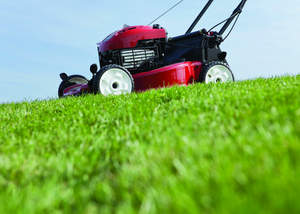MISSION, KS--(Marketwire - April 4, 2011) - (Family Features) Regular lawn mower maintenance is vital to keeping this tool running well. These tips from the experts at TruGreen will help you take care of the workhorse of lawn care.
Sharpen the blade
The sharper the blade, the cleaner your mower will cut the grass, and the better your lawn will look. Dull blades can shred grass and cause discoloration at the tips.
If you don't have the time or the inclination to sharpen the blade yourself, pack up your mower (or carefully remove the mower blade) and take it to a repair shop or home improvement store. For the do-it yourselfer, take a look at these general tips -- for safety, always consult the owner's manual for instructions specific to your machine.
To sharpen a blade:
- Drain the gas and disconnect the spark plug.
- Clamp a piece of wood to the deck to keep the blade from turning.
- Turn the blade bolt counter clockwise to remove it. If there is resistance, apply some penetrating oil, wait 15 minutes and try again.
- Remove the blade and mark the bottom side so you can put it back on correctly.
- Clamp the blade in a bench vise and sharpen with a 10-inch mill file. Use long strokes and work from the center outward. Use the same number of strokes on each side and keep the same angle.
- Balance the blade on a balance tool -- it's an inexpensive pyramid-shaped tool that can be found in most hardware stores. If one side of the blade hangs lower than the other, grind off excess metal from the end of the blade -- not from the part just sharpened.
- Reinstall blade.
When you reinstall the mower blade, make sure you place it at the proper mowing height.
"Letting grass grow tall and then removing more than 1/3 of the leaf blade is called scalping and can damage the lawn," said Ben Hamza, Ph.D., director of technical operations at TruGreen. "Be careful not to mow grass extremely low as you can damage the lawn by cutting into the crowns of the plants."
TruGreen professionals recommend that you measure the grass plants after mowing a very small area, then adjust your mower as necessary. Optimal mowing height varies by type of grass. Experts suggest the following mowing heights, in inches:
- Common Bermuda grass - 1.0 to 1.5
- St. Augustine grass, Bahia grass - 3.0 to 3.5
- Zoysia grass - 1.0
- Rye grass, blue grass, fine fescue - 2.5 to 3.0
- Tall fescues - 2.5 to 3.0
Clean it up
Cleaning your lawn mower not only helps machine performance, it can minimize the spread of lawn disease.
- Empty the gas tank and disconnect the spark plug wire. It's possible for the mower to start on its own when the blade gets turned, which can result in serious injury.
- Rinse mower completely with a water hose from above. Aiming the hose at the side of the mower might get water into the air filter. Wash the outside with sudsy water and sponge. Rinse.
- Turn the mower on its side and clean off any built-up grass with your hands or a putty knife. Wash the underside with soapy water, then gently rinse.
- Let mower dry completely (about an hour).
Maintaining your lawn mower is essential to a lush, green lawn and complements the customized professional lawn, tree and shrub care services TruGreen provides. Taking these simple measures will make mowing easier and help your lawn look great. Learn more at www.TruGreen.com.
Contact Information:
Wendy MacDonald
wmacdonald@familyfeatures.com
1-888-824-3337 ext. 235
http://editors.familyfeatures.com
